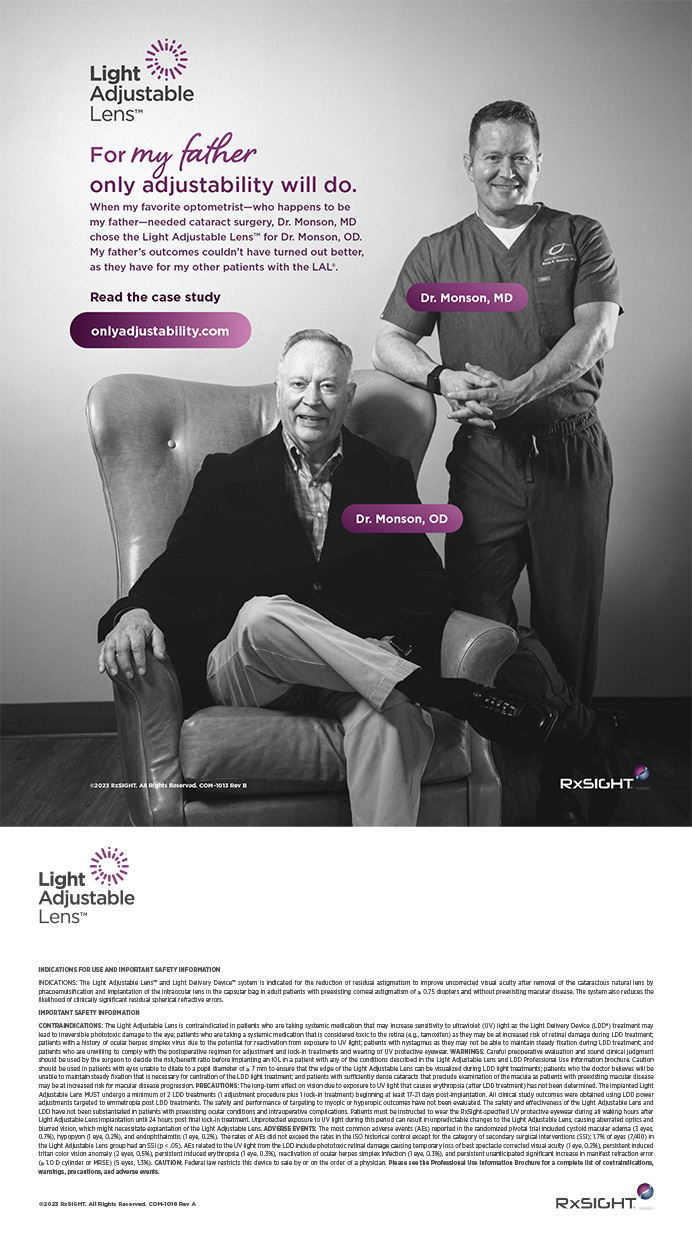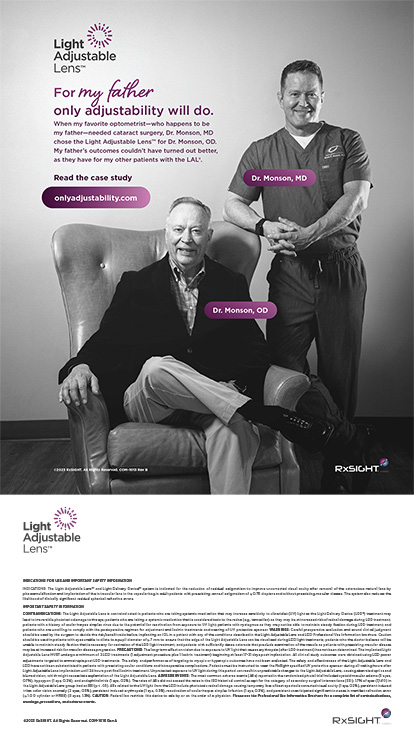Despite the high interest of patients as well as cataract and refractive surgeons in presbyopic correction, the adoption rate of multifocal and accommodating IOLs is relatively low in the United States for a variety of reasons (see Stephen Daily's article on page 58 but also the contrasting perspectives of Mark Rosenberg and Kerry Solomon on pages 62 and 64). Ophthalmologists interested in offering premium lenses (ie, multifocal, accommodating, and toric) or increasing their conversion rates may draw some useful tips from colleagues in another medical specialty, dermatology. These physicians are no strangers to cuts in Medicare reimbursement or the challenges of offering elective procedures.
“Several codes in dermatology have been gutted in recent years, particularly in the areas of skin cancer surgery and surgical destructions such as liquid nitrogen treatment,” Joel Schlessinger, MD, tells Cataract & Refractive Surgery Today. Specializing in dermatology and cosmetic surgery, Dr. Schlessinger is in private practice in Omaha, Nebraska. Because many visits to a typical dermatology practice are elective in nature, the economic recession has hit these physicians hard. He remarks, “[Dermatologists have] had significantly more missed visits, and patients [are] spacing out the treatments more than in the past.”
Dr. Schlessinger's practice is approximately 60% medical and 40% cosmetic, but he says it is unique in that “a very large component of my practice is in clinical research. [At present,] about 20% of my medical practice is involved in clinical research, with 80% in clinical work.”
Generally, remuneration for dermatological services comes from multiple sources: Medicare and Medicaid, private insurers, and the patients themselves. “Approximately 50% of my dollars are self-pay or cosmetic in nature,” Dr. Schlessinger says. “The rest are from insurance, with 75% private pay and 25% Medicare.”
I AM A DOCTOR, NOT A SALESPERSON
Some cataract and refractive surgeons find focusing on conversion rates distasteful and feel like salespeople instead of physicians when they discuss premium IOLs and elective services with patients. According to Dr. Schlessinger, the balancing element here is for physicians only to offer a product or service if they believe in it.
“Way too many people invest in a product or service first, ask questions later, and then are stuck with a product or service that they can't stand and provides poor results,” he says. “[They are then] in the unenviable position of having to sell it to pay off a laser or new service that they are offering. It's terribly important that physicians only bring products, services, and procedures into their offices that they have personally evaluated or have spent a significant amount of time evaluating via other people's input.”
At the heart of a successful premium IOL practice is the ophthalmologist's conviction that the technology is worthwhile and that it will benefit the patient. “If you don't [believe in the offering], it will be obvious to patients, and they will be unhappy with what you are telling them,” says Dr. Schlessinger.
FINANCES ARE NOT A DIRTY LITTLE SECRET
Although many physicians are uncomfortable discussing money with patients, Dr. Schlessinger has found that the latter greatly value a candid exchange on this subject. As the recent economic recession rolled in, he and his staff made a point of helping patients understand their deductibles and costs.
“For example, before an in-office procedure, we discuss its cost with patients and analyze for them what their outof- pocket expense will be,” he explains. “That has proven to be a tremendous help to patients. Many times, they will reconsider a procedure or postpone it. Sometimes, they will delay to another calendar year if they have money set aside in a health savings account. It's all about offering good customer service and empowering patients to understand what they're paying for so that they can plan accordingly.”
Based on Dr. Schlessinger's experience, it would behoove both ophthalmologists and their patients if surgeons discussed the costs of premium IOL procedures and candidates' financial resources.
LOOKING THE PART IS IMPORTANT
Dermatologists have learned that patients judge them and their practices on how they look. “In order to be taken seriously as a cosmetic surgeon, a significant emphasis must be placed on the cosmetic appearance of your practice,” asserts Dr. Schlessinger. “The appearance, however, must reflect the practitioner's personality and the tenor of the community.”
In other words, the physician must be comfortable in his or her own practice, and its layout and appearance must suit the patients who visit it and whom the surgeon wishes to attract. “A Beverly Hills practice would look odd in Kansas,” Dr. Schlessinger notes.
Although elective services are not the bulk of what ophthalmologists provide, those who want to offer premium IOLs or increase their conversion rates should consider their practices' appearance, their communities, and their own personalities.
APPRECIATING PATIENTS IS NOT EXPENSIVE
According to Dr. Schlessinger, letting patients know they are valued influences their decision to pursue an elective procedure, and it has a major effect on their satisfaction with the medical practice. He recommends creating an “ironclad customer service ethic in the office that reflects your values. That will convey to patients that they are coming to the right place for their procedure.”
For cataract and refractive surgeons who want to build the premium IOL channel in their practices, a key component in attracting and satisfying patients is stressing customer service. Frankly, says Dr. Schlessinger, this emphasis should be common to all medical practices, but it is not.
“Unfortunately, it seems only to be adopted when doctors decide that they want to court a cosmetic patient,” he says. Otherwise, many practitioners “concentrate on more pressing matters such as revenue and reimbursement and lose sight of the big picture, which could really help them improve their income,” he adds.
Some aspects of great customer service are free. “A smile at the front desk and a heartfelt thank you when the patient leaves are the least expensive and most effective ways of gaining patients' appreciation,” Dr. Schlessinger notes.
CONCLUSION
As with ophthalmologists, decreased reimbursement and the economic downturn have forced dermatologists across the country to analyze their costs and potential sources of additional revenue (see The Lipstick Effect). For physicians like Dr. Schlessinger, emphasizing customer service and offering only those products and services they believe can benefit their patients have enabled these practitioners to build and maintain successful practices that have a large elective component. Cataract and refractive surgeons who want to have a successful premium IOL practice can take some cues from their colleagues in dermatology by offering technologies they believe have merit, making costs more transparent, sprucing up their offices, and appreciating their patients. That much of this advice is common sense makes it no less valuable.
Joel Schlessinger, MD, is the director of Cosmetic Surgery Forum, a yearly course offered in Las Vegas at the Palazzo Hotel. This year's course will be held from November 29 to December 1, 2012. Information is available at www.cosmeticsurgeryforum.com. He is an investigator for and a consultant to Allergan, Inc. Dr. Schlessinger may be reached at js@cosmeticsurgeryforum.com.


